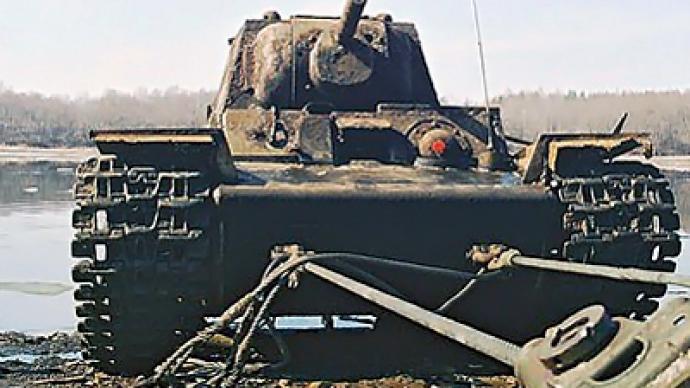WWII tank to leave refuge in Neva River

A World War II KV-1 battle tank has been found resting on the bed of the Neva River near the so-called “Nevsky Pyatachok” – the scene of one of the most critical and costly campaigns during the Siege of Leningrad from September 1941 until May 1943.
According to the commander of the special search squadron Vladimir Mansurov, search and recovery divers are going to examine the river bed and after that that a decision will be made on when the tank will be lifted.This is not the first tank to be found in the Neva River near the Nevsky Pyatachok. Another machine was pulled up from the depths of the river in 2003. After spending more than 60 years in water, the tank remained in excellent condition and was later restored to its full glory and was even able to run after its original engine was reassembled.
Nevsky Pyatachok, a Russian name for the Neva Bridgehead – an area between the Neva’s source and its bend to the south. The name originates from the “Pyatachok” – five-kopeck coin – which reflected the relatively small size of the battlefield: two-and-a-half kilometers of the river’s shore and 700 meters inland. It was the land link between the Soviet-controlled territory and the city defense perimeter. This was besieged Leningrad’s only link which allowed transports to reach the population in with food, medicine and other supplies.The Red Army had to secure this narrow stretch of the shore and prevent German forces from completing the blockade.On 7 September 1941, the German 20th Motorized Division was able to force the elements of the 48th Army out of Shlisselburg, a town situated at the source of the Neva River, setting the stage for a more than two-year struggle to reopen the land communications with Leningrad by the Red Army.The battle for Nevsky Pyatachok extended from September 1941 to May 1943. Operations on this little strip of land resulted in Red Army casualties estimated at 260,000.Today the battlefield of Nevsky Pyatachok is a well-known national and historic landmark in Russia, built as part of a set of memorial facilities at the forefront of the battle for Leningrad – "Green Belt of Glory".
Search missions
In the 1950s, a tradition began in which the children of Leningrad schools took summer trips to the area to search for the remains of those that died there. Various search groups work at the sites of crucial WWII battles and even now, every summer, the remains of Russian and German soldiers are found on the Nevsky Pyatachok.Vladimir Mansurov’s squadron has found the remains of 18 Soviet and one German soldier in the four months of this year alone, along with 30 landmines and shells.
The tank
The KV-1 battle tank, named after Soviet defense commissar and politician Kliment Voroshilov, was widely used during World War II. The KV-1 tanks were known for their extremely heavy armor, which was completely immune to the shells fired from the Panzer III and Panzer IV German tanks.












